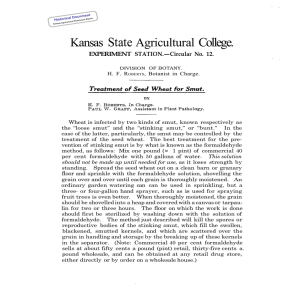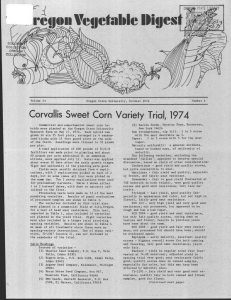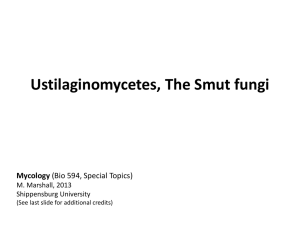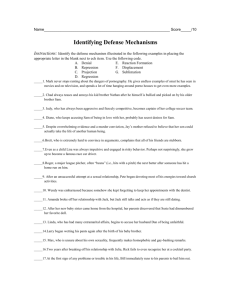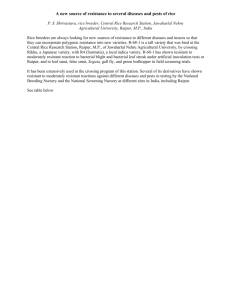Document 13761017
advertisement
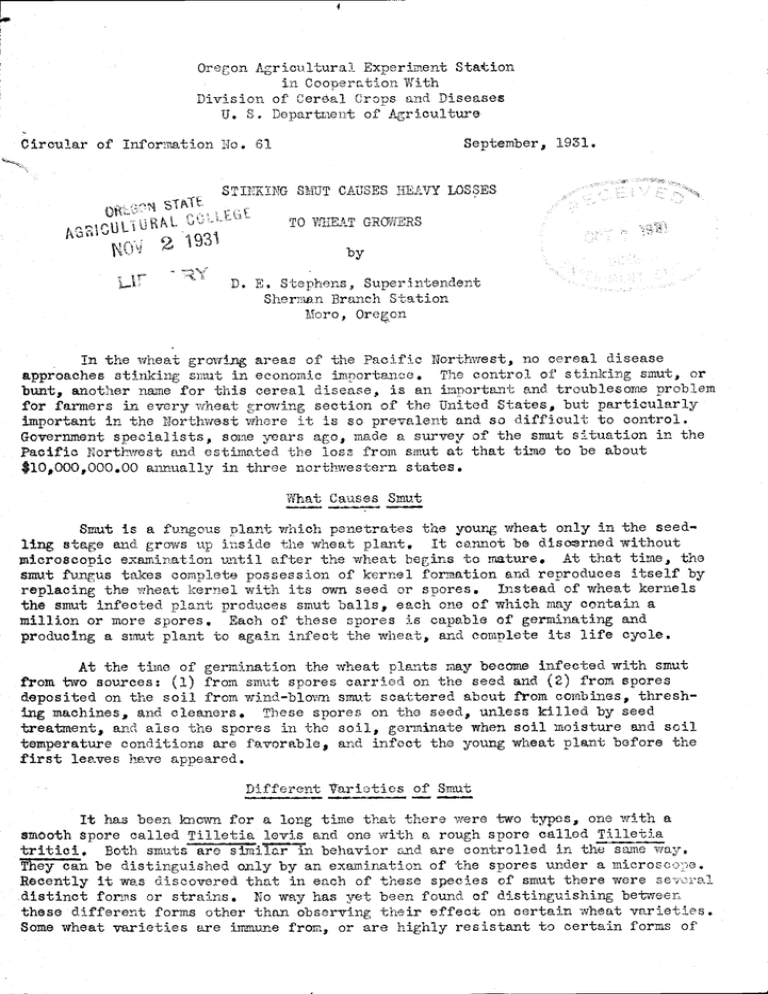
Oregon Agricultural Experiment Station in Cooperation With Division of Ceral Crops and Diseases U. S. Department of Agriculture September, 1931. Circular of Information No. 6. STINEING SMUT CAUSES HEAVY LOSSES o' STP TO YmEAT GROVERS 2 by D. N. Stephens, Superintendent Sherman Branch Station Moro, Oreon In the wheat growing areas of the Pacific Northwest, no cereal disease approaches stInking smut in economic importance. The control of stinking smut, or bunt, another name for this cereal disease, Is an important and troublesome problem for farmers in every wheat growing section of the United States, but particularly important in the Northvest whore it is so prevalent and so difficult to control. Government specialists, some years ago, made a survey of the smut situation in the Pacific Northwest and estimated the lose from smut at that time to be about 1O,OOO,OOO.00 annually in three northwestern states. What Causes Smut Smut Is a fungous plant which penetrates tie young wheat only in the seedIt cannot be disorned without ling stage and grows up inside the wheat plant. Moro800pic examination until after the wheat begins to mature. At that time, the st fungus takes complete possession of kernel formation and reproduces itself by replacing the wheat kernel with its own seed or spores. Instead of wheat kernels the smut infected plant produces smut balls, each one of which may contain a million or more spores, Each of these cpores is capable of germinating and producing a smut plant to agaIn infect the wheat, and complete its life cycle. At the time of germination the wheat plants may become infected with smut from two sources: (1) from smut spores carried on the seed. and (2) from spores deposited on the soil from wind-blorm smut scattered about from combines, threshirig machines, and cleaners. These spores on the seed, unless killed by seed treanent, and also the spores in the soil, gorminatø when soil moisture and soil temperature conditions are favorable, and infect the young wheat plant before the first leaves have appeared, Different VarIoties of Smut It has been known for a long time that there were two types, one wIth a smooth spore called Tilletia levis and one with a rough spore called Tilleia tritiol. Both smuts are similarn behavior and are controlled In the same way. They can be distinguishea oi-dy by an examination of the spores under a microscope. Recently It was discovered that in each of these species of smut there were several distinct forms or strains. No way has yet been found of distinguishing between these different forms other than observing their effect on certain wheat varieties, Some wheat varieties are imaune from, or are highly resistant to certain forms of It is not yet imown how many physiosmut and are susceptible t certain others. logic forms of smut there are, but experimental work at Moro and at Corvallis has proved that there are at least ten forms of bunt, six in the species T. levis and four in T. tritici. An interesting account of this exuerimental work anä other work pertaining to wheat smut is contained in a recently published Oregon Experiment Station Bulletin No, 281 entitled "Varietal Resistance, Physiologic Specialization and Inheritance Studies in 3unt of Wheat," by Dr. E. N. Bressman. How Can Smut be Controlled For many years experiment station workers have been investigating methods of controlling stinking smut in wheat. Much progress has been made, but the smut problem is vet far from being solved. There have been two general methods of Seed treatment, and breeding resistant varieties. attack: The treating of seed with fungicides like formaldehyde and copper sulphate All farmers (bluestone) always has been practiced by eastern Oregon wheat growers. are fni1iar with these methods. During recent years these two methods of treating wheat have been almost entirely replaced by the dust treatmnnt with copper carbonate, which generally gives as good smut control and much less injury to the seed germ, In some sections of Eastern Oregon none of the usual seed treatments will completely control smut; in fact, in parts of Unatilla County, seed treatment is not always effective enough to insure against smut dockage in the crop when susceptible varieties like Hybrid 128 or Federation are grown. Seed containing considerable smut, including smut balls, was sown at the Based on head counts, the resulting Pendleton Field Station in the fall of 1930. crop contained 5.8% smut, when treeted with copper carbonate containing 50% copper and 6.7% smut when treai:ed with coprer carbonate containing 18% copper. When treated with formaldehyde, one pint to 40 gallons of water, -eke crop contained 8.2% smut; and when tree-Bed with binostono, one pound to 5 gallons of water, the crop contained 12.9% smut. When the seed was not treeted, the resulting crop elve different seed treatments were used, and tl contained more than 40% smut. best control was obtained from a double treatment, formaldehyde, 1 pint to 50 gallons of water, the seed dried, and then treated with copper carbonate. Notwithstanding the double treatment, the orop contained 2.6% smut, Thts double treatment injured the seed considerably, reducing the stand 25%, but resulted in a higher yield than from other treatments that did. not control the smut so well. From this experiment and another one in which clean, smut-fxee seed was sown without treetmont, and practically no smut obtained in the crop, it seems that the failure to control smut this season may have been due to the ineffectiveness of seed. treatment on this very smutty seed. rather than to soil infestation. Further experiments are being carried on to get more definite information as to the cause or causes of so much smut being produced in the win±er wheat crop in eastern Oregon even when the seed has boon treated by approved methods. Using seed that is comparatively free from smut doubtless would go a long way towards reducing the amount of smut in the crop. This point freuontly is overlooked by farmers. Smutty wheat never should be used for seed, Even with low wheat prices, it will pay farmers -Be go to considerable trouble or expense to secure seed as free from smut as possible, because smut in the crop moans a yield reduction of several bushels per acre as well as a lower price per bushel. Smut Resistant Varieties The production of varieties of wheat highly resistant to stinking smut gives much p'omise of helping to reduce the present heavy leses now being caused by this disease. I-b is not yet kflown just why some wheat varieties are attacked by 2- smut wo'se than others A few wheat varieties have been produced that are immwie from certain forms of smut and highly resistant to others. Some varieties have proved resistant to some forms and highly susceptible to others. It is quite probable that there are forms of smut in existence that have not yet been tried on these resistant varieties, but they have been inoculated with smut collected from many different localities in the Northwest, as well as from other states, end have still maintained a high degree of resistance. To test these resistant varieties, the seed is blackened with smut spores and planted without treatment. Elien som. in this manner, most corunercial varieties will produce a crop containing from 50 to 95% smutted heads. Smut Trials at Pendieton In this season1s smut trial at the Pondleton Field Station, 27 wheat varieties were sowr with seed blackened with smut spores from each of ten collections of smut originally obtained from various localities in the Pacific Northwest. The lowest average percentage of smut obtained in any variety was seven-tenths of one per cent in Hoonheimer, a late-maturing, smut-resistant variety produced by a German plant breeder. The highest percentage of smut was obtained in Hybrid 126, which had 95.2% of the heads smutted. Following are listed the ten varieties which proved most resistant this par, with the average percentage of smut showm for each variety Rank 1 2 3 4 5 6 7 8 9 10 Smut % Hoextheimer No. 77 Crimean 1532 Oro 8220 0.7 Turkey 7336 Argentine 10061 Turkey x Pd, Mirm, 48 Turkey l558A Ridit Turkey x Florence No. 935 Turkey x Florence No. 932 4.2 6.5 2,8 3.3 9.0 11,7 13.0 14.0 14.4 The ten varieties listed above have been tried for many years for smut resistance at several experiment stations in the western United States, and they have been uniformly high in resistance to this disease, The first eight varieties in the above list are red-kerneled wheats, and six of them wore developed at the Moro Station. Of these six--all wheats of the turkey type--Ore and Argentine are the most promising varieties considering yield and. smut remistance, Both varieties have been distributed to farmers and are now being grown commercially. The variety which ranked eighth in smut rosietanco, Ridit, is a beardless, red-kernelod wheat produced by the Washington Experiment Station at Pullman. It is now commercially established in the Northwest. The only white-kerneled varieties in the ten which averaged highest for smut resistance were the two Turkey x Florence hybrids. These two wheats have the same parentage as Ridit. Neither has been distributed to farmers. Will it Pay to Grow Smut-Resistant Wheats Whether it will pay a farmer to grow any of these smut-resistant varieties will depend upon (1) how difficult it is to control smut in his locality, (2) how '-I they will yield in com.Darjson with standard commercial varieties and. (3) upon market price or auali-Uy. Yield data are available on these varieties from the Nero and Pendleton 8ations and from several outlying nurseries. Several farmers also are growing some of these varieties, and if they prove satisfactory in yield and quality, the acreage sown to them will increase, There uay be new smut forms in certain localities that will attack some of those varieties, us was indicated this year when a colloction of smut from Oraigmont, Idaho, smutted Ridit 37.6%. Oro had only 6.3%. smut when smutted with this Craigwoiit collection. If these resistant varieties are treated, which would be the wise thing to do in areas where smut is very difficult to control, there should be little or no smut in the crop. The treating of resistant varieties may be highly desirable as a precaution against the introduction of new virulent physiologic forms of smut. The following tables give the acre yield in bushels of some of these highly resistant varieties in comparison with Kharkof, a Turkey wheat, Hybrid 128 and Federation, Included in the tables is the variety Albit, a moderately smut -res lotant club wheat which also is commercially grown in the Northwest. Albit must be carefully treated before sowing. 6 yr. average yield, Bu. Field plot trials, Moro: Hybrid 128 Kharkof Ore 26,3 25.2 26,2 24.9 Ridit Federation 24 3 Ar gent inc 7 yr * average Nursery trials, Moro: yield, bu. Hybrid 128 Kharkef Argentine 24,1 20.6 19.4 Ore 20.0 H td it 18.9 Albit 19.6* Federation 21.3 4-yr. average; for the same 4 years Hybrid 128 averaged 22,9 bushels 5 yr. average Nursery trials, Kent: yield,bu. Hybrid 128 Kharkof 22,7 21.3 20.0 21,4 Ar g e n± me Or o R Iciit 19.7 21.8 22,1 Albit Federation -4- 4 yor avorago yield, bu. Nursery_trials, Condon: 27.9 26,7 24 2 24.0 25.3 Hybrid 128 Kharkof Argent mo Or o Ridit Albit 25 8 Federation 29 7 Nursery trials, Culver: 4 yr. average yield, bu. Ridit 13.7 15.0 14 2 14.9 15.8 AlbIt 11 Federation 17.2 Hybrid 128 Kharkof Argentine Or o 5 yr. average yield, bu. Nursery trials, Wasco Co.: 23.2 22.6 23.5 23.6 23.5 Hybrid 128 Kharkc'f ArgentIne Oro Ridit 14.9* Albit 21.3 Federation * 3-year average. Albit yielded 2.5 bushels per acre less than Hybrid 128 for the soae three years. Plot trials, Poncileton: 3 yr. average yield, Hybrid 128 Albit Federation 34.3 32.2 39 2 8 yr average yield, bu, Nursery trials, Pendleton: Hybrid 128 Kharkof Argentine Oro 35.7 $4.7 34.4 34.0 Riclit 32.3 32.9* Albit 34 Federation * 5-year average yield; Hybrid 128 for the sane 5 years averaged 35.2 bu. per acre 7 yr. average yield, bu. Nursery trials, Lexington: 20 9 19.3 19.3 19.3 Hybrid 128 Xharkof Argentine Oro -.5- I'Tursery trials, Lexington (Contd) 7 yr. average yield, bu. 19 3 Rid it Albit 21,2* Federation 19.8 * 5-year average yield; for the same 5 years Hybrid 128 averaged 23.5 bu. per acre Nursery trials, Eigh-bmile: Hybrid 128 Kharkof Argentine 7 yr. average yield, bu. 26.2 23.1 20.8 21.2 22.4 23.0* 30.6 Oro Ridit Albit Federation * 5-ar average yield; Hybrid 126 for the same 5 years averaged 24.6 bu. The yield data in the above tables indicate that in some localities one or more of the smut-resistant varieties will yield as much as present commercial varieties, In some localities, especially at Pendleton, none of the smutresistant wheats seems to be quite high enough in yield to replace Federation or Hybrid 128, the varieties now grown in that county. Re commendations From available data on methods of controlling smut, the experiment station makes the following recommendations: Sow clean seed which is as free from smut as possible. The sowing of smutty seed containing very many smut balls will likely produce a smutty crop. Treat seed with copper carbonate containing 50% copper, using at least two ounces per bushel, and use a treating machine that will thoroughly coat every seed with powder. If clean seed of winter wheat is nob available, it may he advisable to defer sowing until spring. Smut is more easily controlled in spring-sown wheat, amid Federation wheat, sown early in the spring, frequently will out-yield any fall-sean wheat planted late or in dry ground. Planting soon after the first fall rains increases the danger of smut infection. The delaying of seeding three to four weeks after the fall rains will lessen the danger from smut infection from smut spores in the soil; but seeding too late in the fall in some localities will reduce yields. Comparable yields are found in this circular for four smut-resistant and three standard wheat varieties grown at several locations in the Columbia Basin of Oregon. Albit, a moderately smut-resistant white club wheat, averaged one to three bushels per acre less in yield than Hybrid 128 at all locations. Oro, Argentine and: Ridit, highly smut resistant varieties, averaged about the same in yield as Kharkof, a Turkey wheat, 6. - - -cOo- - -
